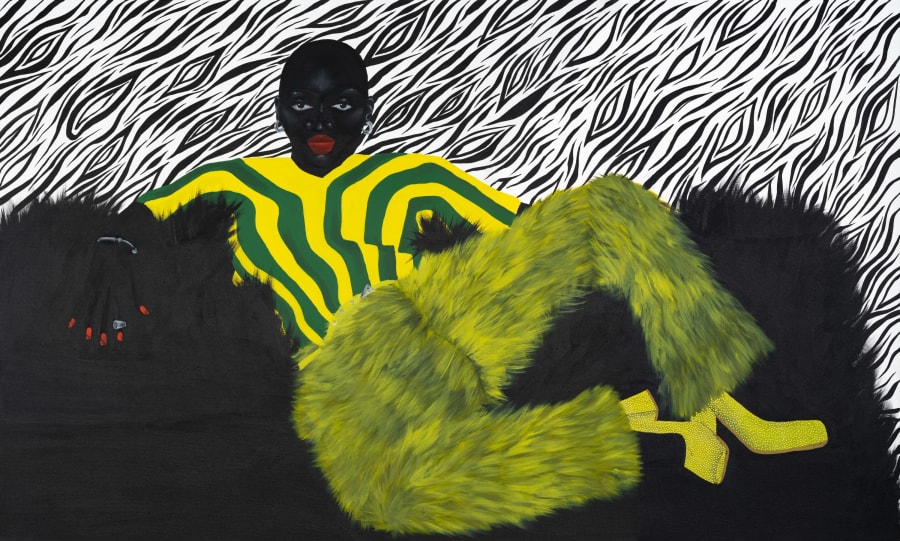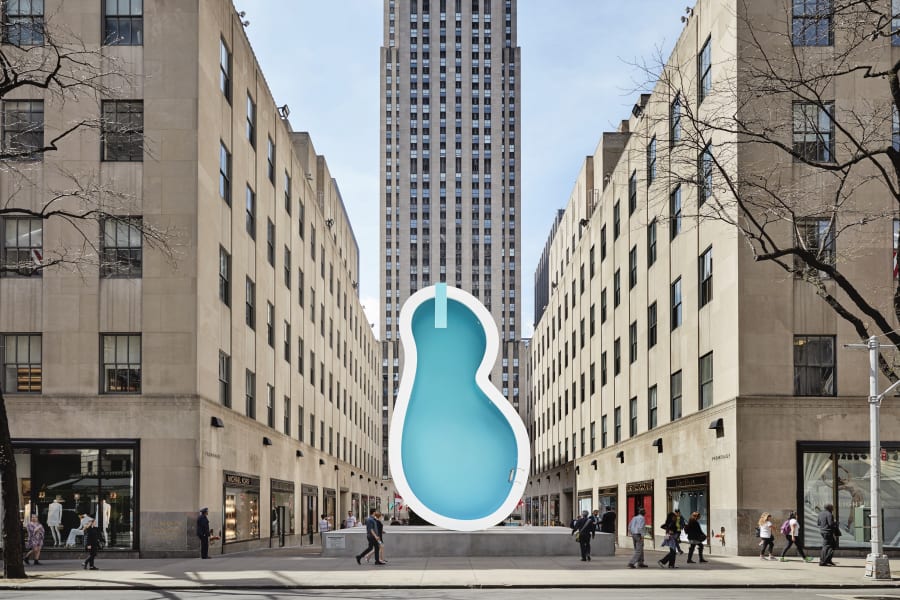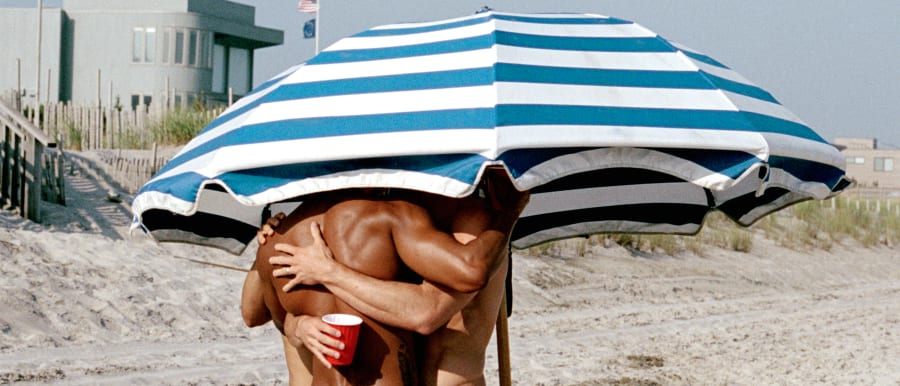With an extinct volcano in the city center and views that stretch to the sea, Edinburgh is a famously beautiful city. Neoclassical sandstone buildings glow pink on long summer evenings, while medieval cobbled alleyways are lined with shops and bars. And as Edinburgh Art Festival (EAF) marks its 20th birthday in 2024, an especially celebratory atmosphere should be tangible across the city in August.
EAF is perhaps the least well known of the Scottish capital’s famous summer festivals, but with hundreds of thousands of visitors each year, it is statistically the largest annual art festival in the UK. With the theater, film, comedy, and book festivals combining to place an international spotlight on Edinburgh, many art institutions look to program their strongest exhibitions for the summer months. This year is no exception.
在這位德國藝術家於紐約貝浩登(Perrotin)舉辦的首次個展「When the Sun Hits the Moon」中,有幾幅畫作是初次亮相,主題為安東尼奧.卡諾瓦(Antonio Canova)的新古典主義雕塑中描繪的愛神厄洛斯與普姬幾乎接吻的場景。愛神不允許他的世間愛人看到他在光明中的樣子;當普姬拿著蠟燭對著愛神面龐的那一刻,這對戀人就永久地斷開了聯繫。Greven說:「我喜歡這個意象,因為我捕捉到的那一刻,他們還在互相對視,但未真正看見對方的面貌。他們仍處於黑暗之中,以內心注視和以內在擁抱。」
EAF is an important point of connection between these artist-led initiatives and the major institutions. In the past, visual art was a significant presence within Edinburgh International Festival itself. Impressionism and Post-Impressionism featured strongly through the 1950s, while exhibitions of work by the Scottish architect Charles Rennie Mackintosh, known for his sinuous Art Nouveau designs, and the Austrian sculptor Fritz Wotruba were organized in the late 1960s. In 1972 the artist Magdalena Abakanowicz gave her street performance Red Rope, documentation from which the EAF director, Kim McAleese, was surprised to see recently at Tate Modern.
Visual art featured less prominently over subsequent decades until, in the early 2000s, senior cultural figures came together to found a new festival. In 2004, EAF was launched – and to keep it going this long has been no mean feat. McAleese identifies persistence as a running thread through this year’s program. ‘We are using this opportunity of our 20th birthday to connect with historic and contemporary ways of organizing that have built infrastructures of care through developing grassroots services and crisis-response networks,’ she says.
The artist Alaya Ang, who moved to Edinburgh recently, also emphasizes the importance of grassroots organizing in the city. ‘The challenge here,’ Ang says, ‘is to find a sense of community that’s DIY, not tied to working with institutions.’ Ang cites work done by local art collectives and student groups in Edinburgh, especially in relation to pushing cultural institutions to adopt more ethical funding frameworks.
Ang is one of four artists selected for EAF’s Platform exhibition, one vital way in which the festival supports artists in Scotland. For Platform, Ang is showing an extension of the long-term project The Sea, The Rope, the Heat, and The Fingers Pulling the Thread. Combining textiles and sound, the work references a specific mud-dyeing technique for gambiered silk that uses iron-rich mud from the Pearl River Delta, which flows into the South China Sea. Two of the textile pieces are also mud-dyed using soil from the River Esk, outside Edinburgh, where water has been polluted by untreated sewage and iron ore deposits from old mines. ‘I’m trying to use textiles to speak of the history of migration and the intertwined layers of industry, environmental changes, and degradation,’ Ang says.
This year, Platform is back in City Art Centre, just across the road from Fruitmarket, having taken place last year in the atmospheric surroundings of Trinity Apse, the surviving structure from a 15th-century church. Over the past two decades, EAF has consistently facilitated contemporary art projects in such non-traditional locations. Striking examples include Thulani Rachia’s obuyile (2021), a composition for four cellists in St Giles Cathedral, and Alberta Whittle’s large-scale performance The Last Born – making room for ancestral transmissions (2023) in Parliament Hall. This August, a car park overlooked by Edinburgh Castle plays host to Prem Sahib’s Alleus, a performance with live vocalists that challenges the dehumanising rhetoric of far-right UK politicians.
Showing contemporary art in such contexts has been one of the festival’s successes, believes the gallerist Richard Ingleby, who was closely involved with founding EAF before becoming a trustee for many years. ‘Especially,’ he says, ‘in bringing historic sites and unlikely buildings into a contemporary focus by introducing art in unexpected ways and places. And in its most recent editions it has worked hard to widen and diversify audiences.’
Having occupied several Edinburgh locations, the husband-and-wife team Richard and Florence Ingleby know as well as anyone how contemporary art can breathe new life into historic spaces. Their gallery’s home since 2018 has been a beautiful former meeting house for the nonconformist Glasite Church, built in 1834. Currently playing host to a series of big, dreamy garden paintings by the LA-based artist Hayley Barker, the ground floor gallery is a neat cube topped by an octagonal stained-glass dome. Upstairs, you can also see work by gallery artists in the former feasting hall, where a long wooden dining table helps to retain a sense of communality amid the pared-back elegance.
While EAF’s 20th anniversary is a cause for celebration, funding is a source of tension this year, particularly in relation to the asset management firm Baillie Gifford, a long-term sponsor of literary festivals across the UK and arts institutions in Edinburgh, where the firm is based. Following the campaigning of artists, writers, and other cultural workers, many of whom live and work in the city, much more is now known about Baillie Gifford’s investments in arms manufacturers and companies that profit from fossil fuels and illegal Israeli settlements in the West Bank.
As a result, Fruitmarket, Collective, and Stills have all cut ties with the firm, as has Edinburgh International Book Festival. However, a Baillie Gifford partner remains chair of Fruitmarket’s board, while National Galleries of Scotland recently announced its commitment to the firm. How EAF manages these divergent responses among festival partners is complex. As McAleese says: ‘One of our roles is to have continued conversations around intersectional and ethical responsibilities of arts institutions.’
For 2024, a key date is EAF’s opening weekend (August 9-11), for which McAleese has invited international artists and activists to connect with practitioners in Scotland. The opening will involve the Lebanon-based feminist collective Haven for Artists, and Más Arte Más Acción, a nonprofit cultural foundation from Colombia, alongside Dundee’s Cooper Gallery, the Edinburgh-based radical bookshop Lighthouse, and Falastin Film Festival, a volunteer-run, not-for-profit collective championing Palestinian visual culture in Scotland. The focus, according to McAleese, is: ‘How can we sustain creative practices at a time of global crises?’ EAF may not have all the answers, but at least it is asking important questions.
Tom Jeffreys is a writer and editor who lives in Edinburgh.
Caption for top image and banner: 1. View of Edinburgh. 2. View of the Edinburgh Sculpture Workshop. All photos and videos by Murray Orr for Art Basel, 2024.
Published on August 8, 2024.


